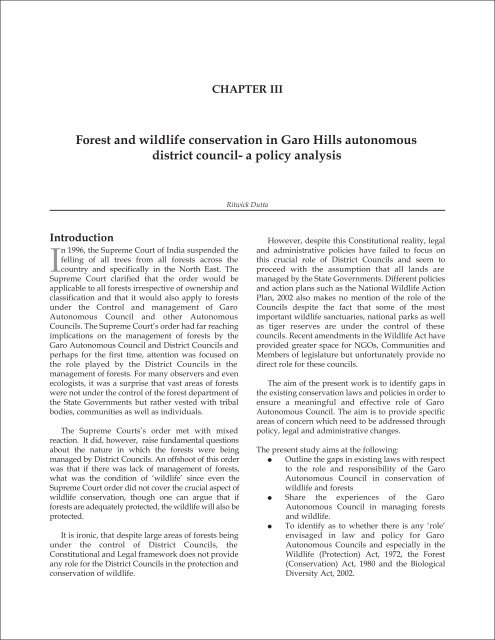Canopies and Corridors - International Fund for Animal Welfare
Canopies and Corridors - International Fund for Animal Welfare
Canopies and Corridors - International Fund for Animal Welfare
You also want an ePaper? Increase the reach of your titles
YUMPU automatically turns print PDFs into web optimized ePapers that Google loves.
Introduction<br />
In 1996, the Supreme Court of India suspended the<br />
felling of all trees from all <strong>for</strong>ests across the<br />
country <strong>and</strong> specifically in the North East. The<br />
Supreme Court clarified that the order would be<br />
applicable to all <strong>for</strong>ests irrespective of ownership <strong>and</strong><br />
classification <strong>and</strong> that it would also apply to <strong>for</strong>ests<br />
under the Control <strong>and</strong> management of Garo<br />
Autonomous Council <strong>and</strong> other Autonomous<br />
Councils. The Supreme Court’s order had far reaching<br />
implications on the management of <strong>for</strong>ests by the<br />
Garo Autonomous Council <strong>and</strong> District Councils <strong>and</strong><br />
perhaps <strong>for</strong> the first time, attention was focused on<br />
the role played by the District Councils in the<br />
management of <strong>for</strong>ests. For many observers <strong>and</strong> even<br />
ecologists, it was a surprise that vast areas of <strong>for</strong>ests<br />
were not under the control of the <strong>for</strong>est department of<br />
the State Governments but rather vested with tribal<br />
bodies, communities as well as individuals.<br />
The Supreme Courts’s order met with mixed<br />
reaction. It did, however, raise fundamental questions<br />
about the nature in which the <strong>for</strong>ests were being<br />
managed by District Councils. An offshoot of this order<br />
was that if there was lack of management of <strong>for</strong>ests,<br />
what was the condition of ‘wildlife’ since even the<br />
Supreme Court order did not cover the crucial aspect of<br />
wildlife conservation, though one can argue that if<br />
<strong>for</strong>ests are adequately protected, the wildlife will also be<br />
protected.<br />
It is ironic, that despite large areas of <strong>for</strong>ests being<br />
under the control of District Councils, the<br />
Constitutional <strong>and</strong> Legal framework does not provide<br />
any role <strong>for</strong> the District Councils in the protection <strong>and</strong><br />
conservation of wildlife.<br />
CHAPTER III<br />
Forest <strong>and</strong> wildlife conservation in Garo Hills autonomous<br />
district council- a policy analysis<br />
Ritwick Dutta<br />
However, despite this Constitutional reality, legal<br />
<strong>and</strong> administrative policies have failed to focus on<br />
this crucial role of District Councils <strong>and</strong> seem to<br />
proceed with the assumption that all l<strong>and</strong>s are<br />
managed by the State Governments. Different policies<br />
<strong>and</strong> action plans such as the National Wildlife Action<br />
Plan, 2002 also makes no mention of the role of the<br />
Councils despite the fact that some of the most<br />
important wildlife sanctuaries, national parks as well<br />
as tiger reserves are under the control of these<br />
councils. Recent amendments in the Wildlife Act have<br />
provided greater space <strong>for</strong> NGOs, Communities <strong>and</strong><br />
Members of legislature but un<strong>for</strong>tunately provide no<br />
direct role <strong>for</strong> these councils.<br />
The aim of the present work is to identify gaps in<br />
the existing conservation laws <strong>and</strong> policies in order to<br />
ensure a meaningful <strong>and</strong> effective role of Garo<br />
Autonomous Council. The aim is to provide specific<br />
areas of concern which need to be addressed through<br />
policy, legal <strong>and</strong> administrative changes.<br />
The present study aims at the following:<br />
Outline the gaps in existing laws with respect<br />
to the role <strong>and</strong> responsibility of the Garo<br />
Autonomous Council in conservation of<br />
wildlife <strong>and</strong> <strong>for</strong>ests<br />
Share the experiences of the Garo<br />
Autonomous Council in managing <strong>for</strong>ests<br />
<strong>and</strong> wildlife.<br />
To identify as to whether there is any ‘role’<br />
envisaged in law <strong>and</strong> policy <strong>for</strong> Garo<br />
Autonomous Councils <strong>and</strong> especially in the<br />
Wildlife (Protection) Act, 1972, the Forest<br />
(Conservation) Act, 1980 <strong>and</strong> the Biological<br />
Diversity Act, 2002.

















